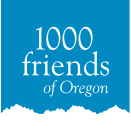By Brett Morgan
Our past transportation advocacy projects include the Coalition for a Livable Future which contested the monstrous Columbia River Crossing, or our 1990’s Land Use Transportation and Air Quality Connection Report (LUTRAQ) that helped show the potential negative air quality impacts of blindly expanding the region’s highways.
We continue to be at the table for transportation decisions across the state, from fighting for transportation funding bonds in Bend and the Portland Region in 2020 to closely tracking and analyzing the I5 Rose Quarter and Bridge Replacement, we continue to show up to advocate for transportation that is accessible, affordable, sustainable, and creates livable communities.
Decisions from where roads and bus lines are placed, how wide roadways are, and if there are sidewalks and bikeways all have direct impacts on how we get around, and in turn, often plays important roles in where we choose to live, and the development of existing and new communities.
At the risk of stating the obvious, transportation policy is land use policy, and who will lead TriMet — Oregon’s largest transit district — does have land use impacts.
In the days right before the Christmas holidays, TriMet announced its General Manager Doug Kelsey was retiring. A search for a new general manager of the $1.5 billion transit agency that serves 2.5 million Portland Metro Residents would begin immediately, before community stakeholders had any opportunity for input. Only after community groups such as the Getting There Together Coalition (which 1000 Friends is an active leader of), and local governments spoke out against the rushed process was it halted, and TriMet and its board began to hear and incorporate some of what the community was calling for.
The GTT coalition, a broad, community-based coalition, just invested three years working collaboratively with TriMet and other regional agencies to create a community-supported vision through the Let’s Get Moving 2020 Transportation Measure. Despite the impact of COVID-19 on people’s lives and livelihoods, our community consistently showed up and spoke out for the need to create a bold vision for the region’s transportation future. Such desires included the long-overdue transit YouthPass, creating hundreds of miles of dedicated bus rapid transit improvements, and creating coordinated anti-displacement coalitions to keep community members rooted.
All of the needs identified through the Let’s Get Moving 2020 Measure remain: Black, Indigenous and People of Color, LGBTQIA+, disabled, elderly and houseless riders face systematic issues with access and safety to and on public transportation. In the context of COVID-19, TriMet will need to rebuild its ridership and find ways to support its core riders, such as essential workers, low-income folks, and BIPOC riders, many of whom already struggled to afford the fare, are living further from the places where they need to go, and now face service cuts.
Our communities are clear in our needs for a shared transportation vision: one that centers climate, equity, a diversity of transportation choices and options, and meets the needs of our growing region.
A vision where access to reliable transit is easy, affordable, electrified, and runs on 100% renewable energy. This future is where the organizing energy lays ready to be activated, where power continues to grow and is the destiny for TriMet and the planet.
This vision is critical to land use: The Portland Metro Region — while growth had slowed prior to COVID-19 — will still continue to encapsulate a majority of the state’s population growth. The results of this growth pre-pandemic was an astronomical increase in commute times and traffic congestion. We know the single most effective way to reduce auto use is by creating livable and walkable communities connected by accessible, affordable, and convenient transportation options like public transit. So a bold vision for public transportation is also a bold vision in the Region’s land use priorities.
How do we make this future a reality? The answers lay in Oregon’s land use goal one: Civic Involvement. The vision 1000 Friends and members of the Getting There Together Coalition see is only possible when TriMet creates an inclusive, transparent, and public hiring process with meaningful participation from community leaders.
A start is ensuring the community is involved every step of the way during TriMet’s search for its next GM, and frankly, it’s a shame that this isn’t where the process began. Community members should have input from the creation of search criteria to the selection of the final candidate, and TriMet’s board of directors should lean on community experience by creating dedicated community stakeholder search seats, including members of our Coalition and TriMet’s Transit Equity Advisory Committee and Committee on Accessible Transportation. We‘re continuing to track opportunities for engagement at GettingThereTogether.org.
Members of TriMet’s Board of Directors and agency leaders have a momentous opportunity to attract a leader through a fair and open process that can rise to the many challenges facing the agency while ensuring the actualization of a bold vision for our transportation system in the Portland Metro Region, but only when TriMet centers Goal 1.
